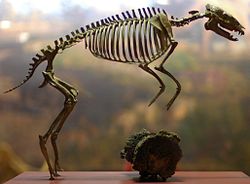| Eohippus Temporal range: Ypresian, | |
|---|---|
 | |
| Reconstructed skeleton, National Museum of Natural History, Washington, D.C., United States | |
| Scientific classification | |
| Kingdom: | Animalia |
| Phylum: | Chordata |
| Class: | Mammalia |
| Order: | Perissodactyla |
| Family: | Equidae |
| Genus: | † Eohippus Marsh, 1876 |
| Species: | †E. angustidens |
| Binomial name | |
| †Eohippus angustidens (Cope, 1875) | |
| Synonyms | |
| |
Eohippus is an extinct genus of small equid ungulates. [1] The only species is E. angustidens, which was long considered a species of Hyracotherium (now strictly defined as a member of the Palaeotheriidae rather than the Equidae). Its remains have been identified in North America and date to the Early Eocene (Ypresian stage). [2]









